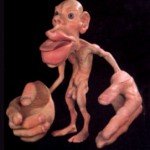David Baxter PhD
Late Founder
Body Image Distortion: As Nature Intended?
Wednesday, July 7th, 2010
What if you?re not as fat as your brain thinks you are?
According to research by Matthew Longo and other neuroscientists at the University College London, this is a definite possibility. In their study, Longo and his colleagues asked volunteers to place their left hand palm-side-down underneath a board and to then estimate the size of their hand by identifying landmarks such as fingertip and knuckle locations. As it turns out, volunteers consistently overestimated the width of their hand?sometimes by up to 80%.
While Longo and his colleagues have discovered the ?what,? however, they have not yet quite determined the ?why.? After all, what advantage is there to representing the body as overly wide?
The brain naturally uses proprioception to create internal maps of the body, many of which are distorted for specific reasons. One such map is the cortical homunculus: a map that represents the amount of cortex devoted to:
1) processing stimuli and
2) controlling motor functions in each portion of the body.

When represented pictorially, this map shows body parts significantly out of proportion; this is because more cortex is required to oversee finer movements and greater concentrations of nerve endings in areas such as the fingertips or lips than in, say, the chest or leg.
Nevertheless, Longo and his colleagues? findings could shed some insight into the neurological causes of eating disorders. If the mind implicitly believes the body to be wider than it really is, then that mental representation may be over exaggerated in individuals with conditions such as anorexia nervosa, where body image is distorted.
1 Longo, M., & Haggard, P. (2010). An implicit body representation underlying human position sense Proceedings of the National Academy of Sciences, 107 (26), 11727-11732 DOI: 10.1073/pnas.1003483107
2 Liechty, J. (2010). Body Image Distortion and Three Types of Weight Loss Behaviors Among Nonoverweight Girls in the United States Journal of Adolescent Health DOI: 10.1016/j.jadohealth.2010.01.004
Wednesday, July 7th, 2010
What if you?re not as fat as your brain thinks you are?
According to research by Matthew Longo and other neuroscientists at the University College London, this is a definite possibility. In their study, Longo and his colleagues asked volunteers to place their left hand palm-side-down underneath a board and to then estimate the size of their hand by identifying landmarks such as fingertip and knuckle locations. As it turns out, volunteers consistently overestimated the width of their hand?sometimes by up to 80%.
While Longo and his colleagues have discovered the ?what,? however, they have not yet quite determined the ?why.? After all, what advantage is there to representing the body as overly wide?
The brain naturally uses proprioception to create internal maps of the body, many of which are distorted for specific reasons. One such map is the cortical homunculus: a map that represents the amount of cortex devoted to:
1) processing stimuli and
2) controlling motor functions in each portion of the body.

When represented pictorially, this map shows body parts significantly out of proportion; this is because more cortex is required to oversee finer movements and greater concentrations of nerve endings in areas such as the fingertips or lips than in, say, the chest or leg.
Nevertheless, Longo and his colleagues? findings could shed some insight into the neurological causes of eating disorders. If the mind implicitly believes the body to be wider than it really is, then that mental representation may be over exaggerated in individuals with conditions such as anorexia nervosa, where body image is distorted.
- Read the research behind Longo?s findings. 1
- Investigate body image distortion and how it affects disordered eating. 2
- Find out more about cortical homunculi.
1 Longo, M., & Haggard, P. (2010). An implicit body representation underlying human position sense Proceedings of the National Academy of Sciences, 107 (26), 11727-11732 DOI: 10.1073/pnas.1003483107
2 Liechty, J. (2010). Body Image Distortion and Three Types of Weight Loss Behaviors Among Nonoverweight Girls in the United States Journal of Adolescent Health DOI: 10.1016/j.jadohealth.2010.01.004
